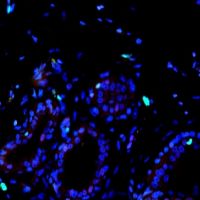Patients with glioma – a low-grade type of
brain tumour – who received radiation therapy plus a chemotherapy regimen,
including procarbazine, lomustine and vincristine (PCV), experienced a longer
progression-free and overall survival than patients with only radiation therapy,
according to the results of the clinical trial, Radiation Therapy Oncology
Group (RTOG) 9802 published in the New England Journal of
Medicine.
“This is the first phase III trial to demonstrate conclusively a treatment-related survival benefit for patients with grade 2 glioma,” said the study’s lead author Jan Buckner, M.D., oncologist and chair of the Department of Oncology at the Mayo Clinic Cancer Center in Rochester, Minnesota.
“Our early results, reported at a median patient follow-up of 5.9 years, showed that radiation therapy plus PCV chemotherapy was associated with a statistically significant prolongation of median progression-free survival, but not with overall survival. However, additional follow-up demonstrated an improvement in overall survival as well for these patients,” said Dr. Buckner (see video interview).
Between October 1998 and June 2002, a total of 251 patients with low-grade glioma were enrolled in the RTOG 9802 trial. Patients enrolled were at high risk, compared to other patients with low-grade glioma, because they were 40 or older, or had a less-than-complete surgical removal of their tumour.
Patients were randomised to one of two trial arms, radiation therapy plus six cycles of PCV chemotherapy or radiation therapy alone. Before treatment, researchers conducted a pathology review on tumour samples and prepared for samples for correlative laboratory studies to assess mutational status and identify prognostic variables.
At a median follow-up time of 11.9 years, 67 per cent of enrolled patients were identified as having tumour progression, and 55 per cent of patients had died. Patients in the radiation therapy plus PCV chemotherapy arm had longer median survival times, compared with those in the trial arm who received radiation therapy alone (13.3 versus 7.8 years, respectively; p=0.003).
For progression-free survival and overall survival distributions, a difference between treatment arms became apparent only after two to four years following randomisation. The favourable prognostic variables researchers identified for progression-free and overall survival included the radiation plus PCV chemotherapy arm and oligodendroglioma histology.
Treatment toxicity was greater in the PCV chemotherapy arm and consistent with patients receiving multiagent chemotherapy regimens. The most common toxicities were fatigue, anorexia, nausea and vomiting, which were mostly grade 1-2 in severity with the exception of grade 3-4 neutropenia.
“Our results indicate that initial radiation therapy followed by PCV is necessary to achieve longer survival in patients with grade 2 glioma and that salvage therapy at relapse after radiation therapy alone is less effective,” said Dr. Buckner. “It has also been hypothesised that other genetic alterations may be responsible for a small subset of patients whose glial brain tumours are chemotherapy-resistant. However, radiation therapy plus PCV appears to represent the most effective treatment identified to date for the majority of patients with grade 2 glioma,” Dr. Buckner said.
While grade 2 glioma constitute only 5 to 10 per cent of all brain tumours, they are responsible for progressive neurologic symptoms and premature death in nearly all patients diagnosed with this type of brain tumour.
“RTOG 9802 involves a network of investigators across the U.S. and Canada working through the National Cancer Institute’s National Clinical Trials Network,” said Dr. Buckner. “This trial could only have been conducted through a publicly funded national clinical trials network.”
Reference:
Jan C. Buckner, Edward G. Shaw, Stephanie L. Pugh, Arnab Chakravarti, Mark R. Gilbert, Geoffrey R. Barger, Stephen Coons, Peter Ricci, Dennis Bullard, Paul D. Brown, Keith Stelzer, David Brachman, John H. Suh, Christopher J. Schultz, Jean-Paul Bahary, Barbara J. Fisher, Harold Kim, Albert D. Murtha, Erica H. Bell, Minhee Won, Minesh P. Mehta, Walter J. Curran. Radiation plus Procarbazine, CCNU, and Vincristine in Low-Grade Glioma. New England Journal of Medicine, 2016; 374 (14): 1344 DOI: 10.1056/NEJMoa1500925
Source:



























